Why Mediterranean Cucumber Salad Belongs on Your Table
Hi, I’m Mia founder of EatBrightly, chef by heart, and forever fascinated by food that feels as good as it tastes. If you’ve ever found yourself craving a dish that’s fresh, crisp, and deeply satisfying without weighing you down, you’re going to love this Mediterranean Cucumber Salad.
This isn’t just any summer side it’s a bright, hydrating salad I come back to time and time again, especially on warm Asheville afternoons when my herb garden is buzzing, and Luna, my rescue pup, is snoozing by the kitchen door. With its roots in the sun-kissed cuisines of Greece, Lebanon, and Turkey, this salad is a celebration of vibrant, simple ingredients like cool cucumbers, juicy tomatoes, briny olives, and zesty vinaigrette that nourish the body and lift the spirit.
My journey with real food began at family dinners in upstate New York and deepened after a personal health reset in my twenties. What I’ve learned since is this: eating well doesn’t have to be complicated, restrictive, or boring. It should be joyful, colorful, and full of flavor exactly like this cucumber salad.
So whether you’re new to intuitive eating, a seasoned plant-based home cook, or simply someone looking for a clean, crunchy, and downright delicious salad, you’re in the right place. In this article, we’ll dive into what makes Mediterranean Cucumber Salad a star, explore its health benefits, discover variations, and even answer the most common questions people ask about it.
Let’s get started your salad bowl is about to get a whole lot brighter.
Table of Contents
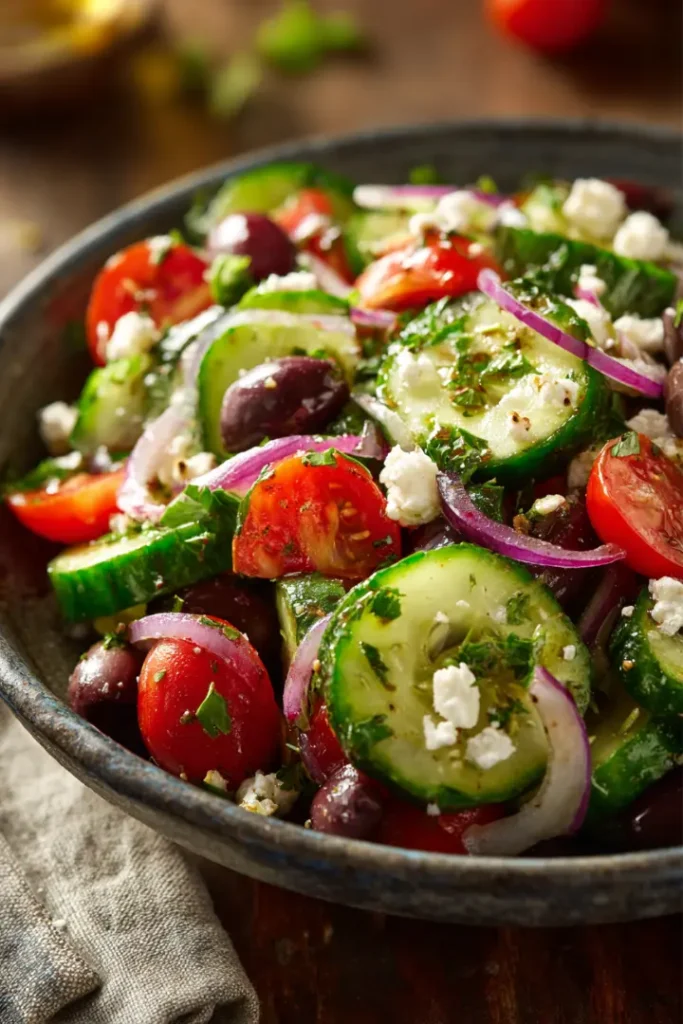
Core Ingredients in Mediterranean Cucumber Salad
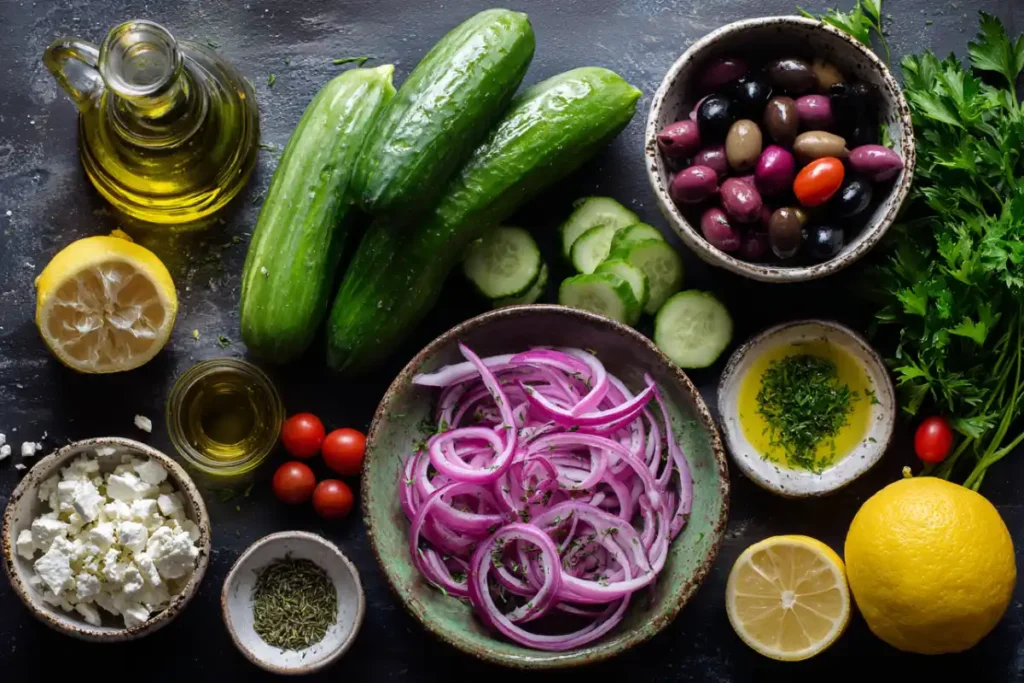
Choosing the Best Cucumber: English vs Persian
At the heart of every Mediterranean cucumber salad is of course the cucumber. But not all cucumbers are created equal. For the best texture and taste, I always reach for English cucumbers or Persian cucumbers. Why? Because they’re seedless, less watery, and have thin skins you don’t need to peel perfect for a fresh summer salad.
English cucumbers tend to be longer and smoother, offering a clean, slightly sweet crunch. Persian cucumbers, on the other hand, are shorter and firmer, with a bolder bite. Either variety will do beautifully in this dish, but if you spot Persian cucumbers at your local farmers’ market, grab them they hold their texture better when dressed.
If you’re using standard slicing cucumbers (the thick-skinned kind), just peel and scoop out the seeds before chopping. The texture won’t be as delicate, but it’ll still work in a pinch.
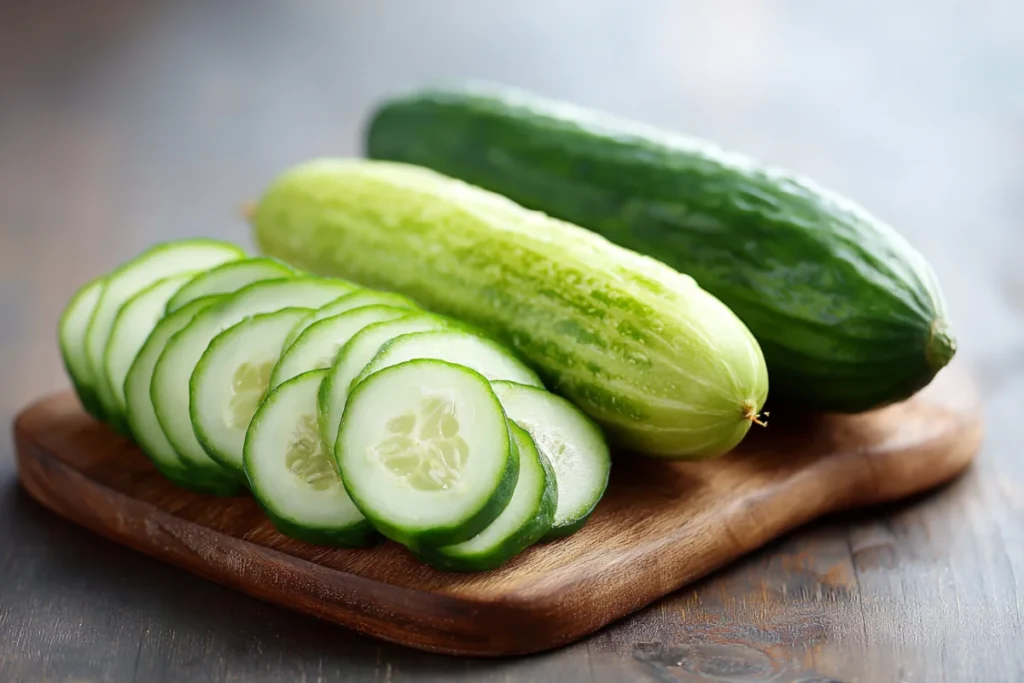
Traditional Mediterranean Vegetables: Tomatoes, Olives, Onions
Next comes a mix of ripe tomatoes, briny olives, and thinly sliced red onions a trio that brings bold flavor and vibrant color.
Tomatoes should be juicy, sweet, and not too firm. I prefer cherry tomatoes halved or heirlooms diced, depending on what’s in season. Their natural acidity balances the coolness of the cucumber perfectly.
Olives add that unmistakable salty kick. Kalamata olives are the classic choice, but green olives or Castelvetrano varieties can offer a milder, fruitier bite.
Red onions, when sliced ultra-thin, give just enough sharpness without overpowering the dish. If raw onion is too intense for you, a quick soak in cold water can tame the bite without losing flavor.
Together, these ingredients build the foundation of that unmistakable Mediterranean flavor profile simple, fresh, and unforgettable.
Fresh Herbs That Define the Flavor
No Mediterranean cucumber salad is complete without a generous handful of fresh herbs. This is where the flavor really comes alive.
- Parsley brings brightness and a touch of peppery sharpness.
- Mint adds a cool, almost sweet lift that plays perfectly against tangy dressing.
- Dill, though not traditional in all regional variations, pairs beautifully with cucumber and offers a distinct aromatic note.
Use one, two, or all three depending on your taste. I personally love combining parsley and mint it reminds me of the first time I recreated this salad after visiting a Greek taverna in Santorini. The flavors are clean, crisp, and unmistakably Mediterranean.
Dressings that Elevate the Taste
Classic Vinaigrettes vs Greek-Style Lemon Dressings
A great Mediterranean cucumber salad is only as good as its dressing. It’s where everything ties together adding tang, richness, and that signature Mediterranean zing.
Most traditional recipes use a simple vinaigrette made from olive oil, red wine vinegar, garlic, and lemon juice. This blend brings balance to the cool crunch of cucumber and juicy tomatoes. You’ll often see a Greek-style lemon dressing in variations, featuring extra lemon juice, oregano, and a pinch of sea salt. It’s zesty, herbaceous, and wonderfully bright.
Here’s a quick comparison of both styles:
| Dressing Type | Key Ingredients | Flavor Profile |
|---|---|---|
| Classic Mediterranean | Olive oil, vinegar, garlic, salt, black pepper | Balanced & earthy |
| Greek Lemon Dressing | Olive oil, lemon juice, oregano, garlic | Tangy & herb-forward |
Whichever you choose, the key is quality extra virgin olive oil. That golden drizzle doesn’t just add healthy fats, it enhances every other ingredient with richness and body.
How to Make Your Own Homemade Dressing
You don’t need a bottled dressing to enjoy full flavor. In fact, a homemade version takes just a few minutes and tastes ten times fresher.
Here’s a go-to Mediterranean vinaigrette I use often at EatBrightly:
Basic Mediterranean Cucumber Salad Dressing:
- 1/4 cup extra virgin olive oil
- 2 tbsp red wine vinegar (or lemon juice for Greek style)
- 1 minced garlic clove
- 1/2 tsp dried oregano
- Sea salt and cracked black pepper to taste
- Optional: a touch of Dijon mustard for creaminess
Whisk it all in a bowl or shake it up in a mason jar. That’s it. Drizzle over your chopped vegetables just before serving, and gently toss to coat.
Sometimes I add a spoonful of sumac a tangy Middle Eastern spice for an extra citrusy punch. Other times, a squeeze of honey rounds things out when my tomatoes are extra tart. Let your senses guide you.
Looking to refresh your weekly meals with vibrant, nutrient-rich options? Fresh Mediterranean Salads: 5 Easy & Delicious Recipes brings you a curated collection of simple yet flavorful salads inspired by the heart-healthy Mediterranean lifestyle. Whether you’re craving something light and crisp or hearty and satisfying, these recipes are packed with seasonal vegetables, herbs, and zesty dressings to keep your meals exciting and nourishing.
What Not to Mix in Cucumber Salad: Common Mistakes
While Mediterranean cucumber salad is forgiving, there are a few ingredients I recommend keeping out of the bowl.
Creamy dressings like ranch or sour cream-based sauces? Leave them for other dishes. They tend to overpower the fresh, herb-driven nature of the salad.
High-moisture vegetables like zucchini or iceberg lettuce can water down the dish quickly. Stick with sturdy, crisp veggies that hold up well after dressing.
Over-marinating is another common misstep. While the salad should be dressed shortly before serving, letting it sit too long can cause the cucumbers to go soggy. If you’re prepping ahead, store the chopped veggies and dressing separately and toss them together right before eating.
Remember, simplicity is part of the magic. A few fresh ingredients and the right dressing are all you need.
Mediterranean vs Greek Cucumber Salad
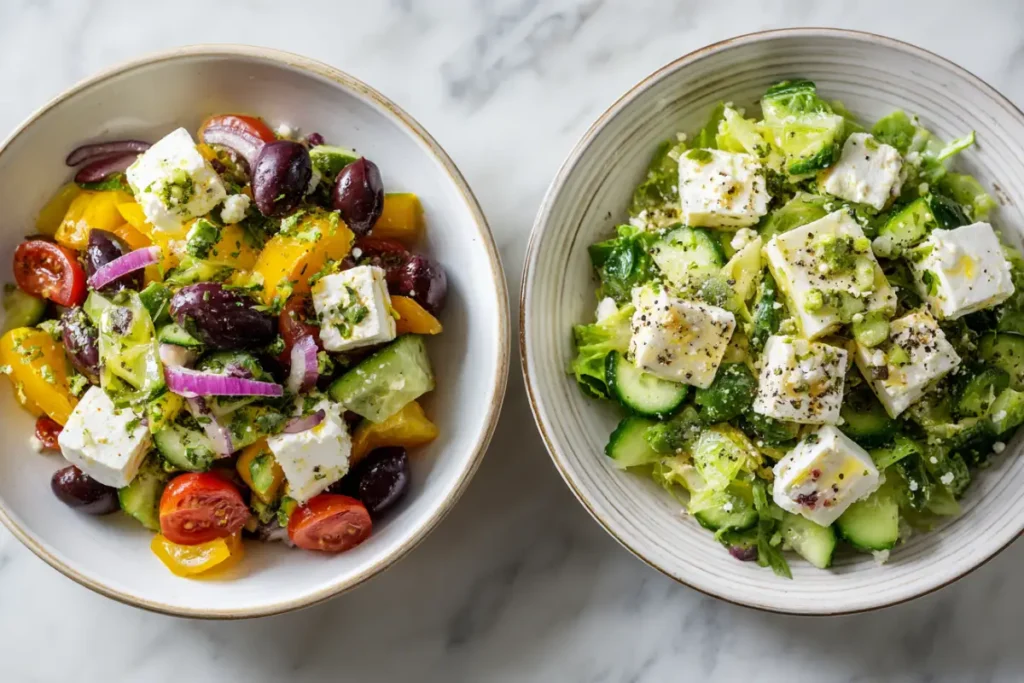
Key Differences in Ingredients and Flavors
At first glance, Mediterranean cucumber salad and Greek cucumber salad may seem nearly identical. Both showcase crisp cucumbers, juicy tomatoes, briny olives, and a zesty dressing. But there are subtle and flavorful differences worth noting.
A classic Greek cucumber salad often includes feta cheese, a good splash of red wine vinegar, and a heavier hand with oregano. It’s bolder, saltier, and a bit more structured in flavor.
In contrast, a broader Mediterranean cucumber salad might vary by region—drawing inspiration from Lebanese tabbouleh, Israeli chopped salad, or Turkish shepherd’s salad. You’ll see a wider use of fresh herbs like mint or dill, chickpeas, and even bell peppers or radishes added for crunch and color. The flavor here is more herb-forward and citrus-bright.
Here’s a quick visual breakdown:
| Salad Type | Typical Ingredients | Signature Taste |
|---|---|---|
| Greek Cucumber Salad | Cucumber, tomato, feta, red onion, olives, oregano | Bold, tangy, salty |
| Mediterranean Variation | Cucumber, tomato, mint, parsley, chickpeas, lemon dressing | Fresh, herbaceous, zesty |
Is Greek Salad a Type of Mediterranean Cucumber Salad?
Yes but also no. Greek salad can absolutely fall under the Mediterranean umbrella, but not every Mediterranean cucumber salad is Greek. That’s because the Mediterranean diet spans dozens of countries and cultures from Spain and France to Lebanon, Egypt, and Morocco each putting its unique spin on ingredients.
Think of Greek salad as a popular regional branch on the wide and flavorful Mediterranean tree.
If you love the feta-forward flavor of Greek-style salads, try crumbling a bit into your cucumber mix. But if you’re after something lighter, vegan, or more herbal, skip the cheese and lean into lemon and mint instead.
Comparing Textures and Toppings
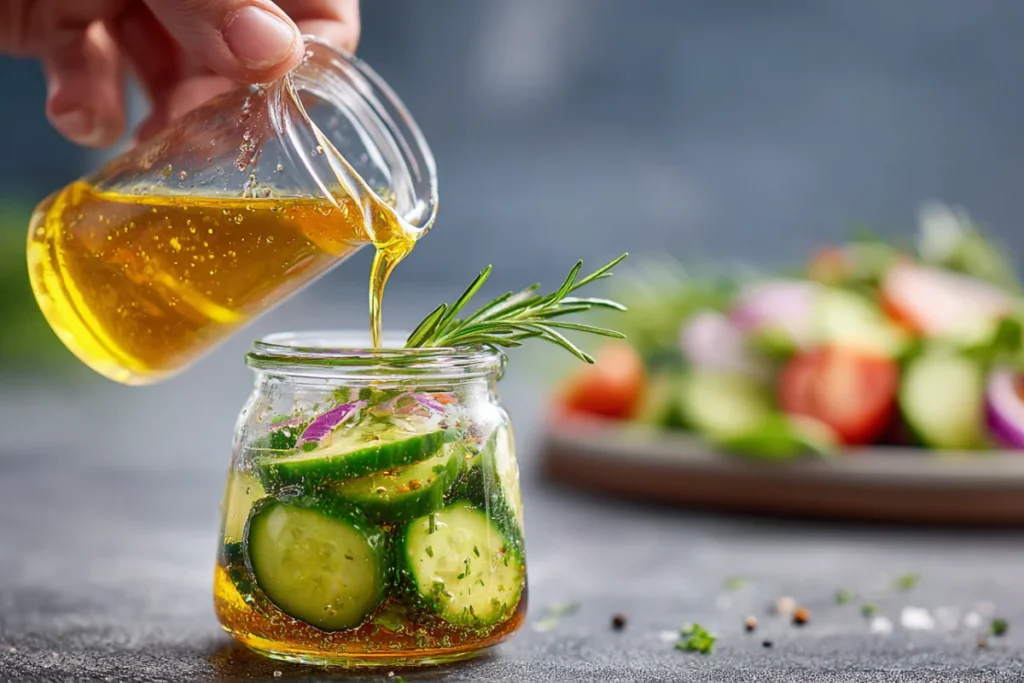
Another small but impactful distinction? Texture.
Greek salads are typically chunkier with large tomato wedges, thick cucumber slices, and big blocks of feta. Mediterranean cucumber salads, especially those inspired by Middle Eastern traditions, are often finer chopped, giving them a scoopable, almost tabbouleh-like texture.
Topping-wise, you might see capers, pine nuts, or even a dusting of za’atar in regional Mediterranean versions. Greek salads stick more strictly to tradition, which is beautiful in its own way but don’t be afraid to experiment.
Nutritional Benefits of Mediterranean Cucumber Salad
Health Advantages of Fresh Veggies and Olive Oil
It’s no secret that the Mediterranean cucumber salad is more than just refreshing it’s packed with nutrients that support your well-being from head to toe.
Let’s start with the base ingredients: cucumbers, tomatoes, red onions, and olives. Each offers its own nutritional boost. Cucumbers are mostly water so they’re incredibly hydrating and low in calories. Tomatoes bring lycopene, a powerful antioxidant that supports heart health. Red onions offer quercetin, known for its anti-inflammatory effects. And olives? They’re rich in healthy monounsaturated fats and vitamin E.
But the real superstar here might be the extra virgin olive oil. It’s the foundation of most Mediterranean diets and is proven to:
- Lower bad cholesterol (LDL)
- Boost heart and brain health
- Provide antioxidants that fight oxidative stress
When you pair all these together in one dish, you’re getting a fiber-rich, plant-powered side that checks every box: light, filling, heart-healthy, and delicious.
Anti-Inflammatory and Heart-Health Properties
One of the biggest benefits of eating this way is its natural anti-inflammatory profile. Fresh vegetables, healthy fats, and herbs like parsley, dill, and mint all contribute compounds that help reduce chronic inflammation a major driver of disease.
Olive oil, in particular, contains oleocanthal, a compound that works similarly to ibuprofen in fighting inflammation. Combined with the antioxidants in red onions, vitamin C from tomatoes, and hydrating cucumbers, this salad delivers a protective boost with every bite.
It’s no wonder the Mediterranean diet is often recommended for preventing heart disease, supporting healthy blood pressure, and even managing blood sugar.
Hydration and Fiber Benefits
If you’ve ever felt bloated or sluggish after a heavy meal, this salad is your antidote. Thanks to its high water content, Mediterranean cucumber salad helps you stay hydrated—especially during the warmer months.
Here’s why it matters:
- Cucumbers are 96% water, helping flush toxins and support kidney function
- Tomatoes and bell peppers contribute water and electrolytes
- Onions and herbs aid digestion and reduce water retention
And let’s not forget fiber. The vegetables in this salad provide both soluble and insoluble fiber, which supports gut health, regulates blood sugar, and keeps you full longer without adding heaviness.
The Mediterranean cucumber salad isn’t just delicious it’s backed by real science. According to research from Harvard, the Mediterranean diet is associated with a reduced risk of heart disease, diabetes, and cognitive decline, thanks to its emphasis on whole foods, healthy fats, and fresh produce.
Learn about the science behind the Mediterranean diet from Harvard T.H. Chan School of Public Health.
So, not only is this salad easy on your system it helps it function better.
Variations and Add-ins
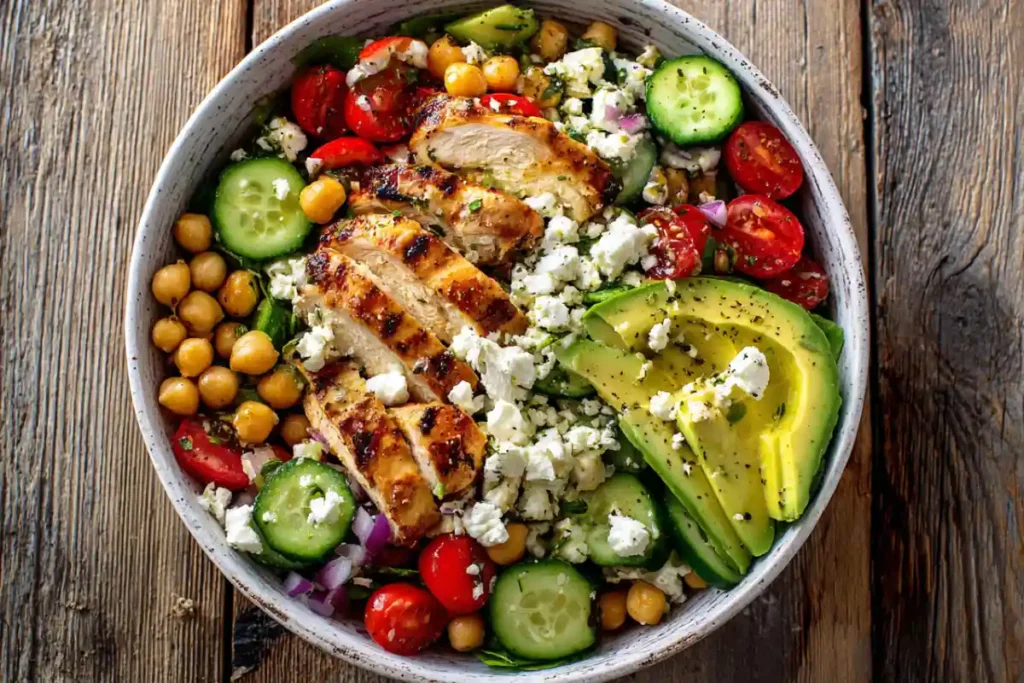
Vegan, Vegetarian, and Keto-Friendly Twists
One of the best things about a Mediterranean cucumber salad is how versatile it is. Whether you follow a plant-based lifestyle, low-carb plan, or just want to mix things up, this salad adapts beautifully.
For a vegan version, simply skip the cheese or replace it with a dairy-free feta alternative. You can even crumble in some marinated tofu for added protein. The salad stays just as crisp, colorful, and satisfying.
If you’re on a keto diet, this salad is practically made for you. It’s naturally low in carbs and high in fiber. To boost the fat content for a more keto-friendly twist, toss in:
- Extra olives
- Avocado chunks
- A spoonful of tahini or hemp seeds
Prefer vegetarian but want it heartier? Add a scoop of quinoa, couscous, or even a handful of roasted chickpeas for texture and fullness. These extras make the salad meal-worthy without losing its Mediterranean soul.
Adding Proteins: Feta, Chickpeas, or Grilled Chicken
Adding protein is a great way to turn this dish into a satisfying main course. Here are a few crowd-pleasing ideas:
- Feta Cheese: A traditional choice. It adds creaminess, tang, and salt. For even more flavor, use block-style feta in brine then crumble it yourself.
- Chickpeas: For a vegan protein punch, chickpeas are perfect. They soak up the dressing like a sponge and give the salad a hearty bite. Try them roasted for crunch.
- Grilled Chicken: Sliced lemon-herb grilled chicken turns your side salad into a full lunch or dinner. Bonus points if it’s fresh off the grill.
Not into meat or legumes? Add hard-boiled eggs, tuna, or even sliced tempeh for a creative spin. The salad plays well with nearly any protein source, making it a go-to for diverse dietary needs.
How to Make It a Full Meal
With just a few thoughtful additions, this cucumber salad transforms from side dish to star of the table. Here’s how I like to build a balanced Mediterranean bowl:
Base: Mediterranean cucumber salad
Grain: Farro, bulgur, or quinoa
Protein: Chickpeas, grilled halloumi, or seared shrimp
Greens: Baby arugula, romaine, or spinach
Extras: Hummus scoop, roasted red pepper, lemon wedge
Drizzle with a bit more dressing, top with chopped herbs, and enjoy a full-flavored, nutrient-packed meal in one bowl.
How to Serve and Store Mediterranean Cucumber Salad
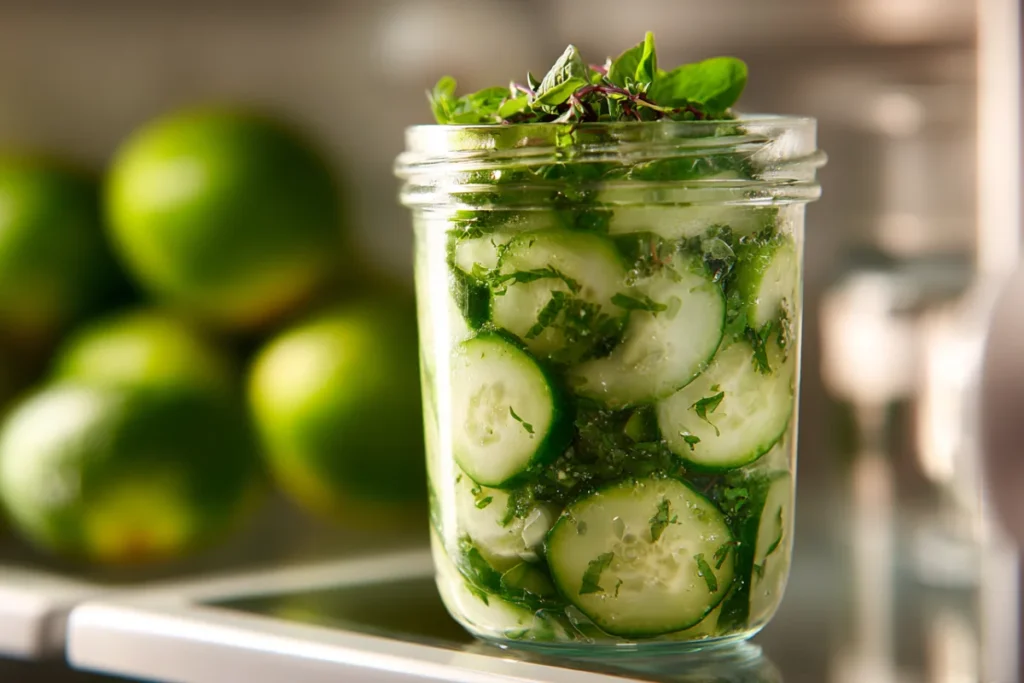
Best Pairings: Grilled Meats, Falafel, Pita
Mediterranean cucumber salad is incredibly flexible. It’s light enough to complement rich dishes and bold enough to hold its own. Whether you’re planning a backyard barbecue or a casual family dinner, this salad fits right in.
Some of my favorite pairings include:
- Grilled lemon chicken or lamb skewers – The salad cuts through the richness of grilled meat beautifully.
- Falafel or veggie patties – Perfect for plant-based eaters; the cucumber adds cool crunch against warm, spiced bites.
- Stuffed pita or wraps – Spoon the salad into pita pockets with hummus or baba ganoush for a quick lunch.
- Seafood dishes – Grilled shrimp, salmon, or even a tuna steak pair effortlessly thanks to the salad’s citrus-forward dressing.
For gatherings, serve it in a large shallow bowl so everyone gets a taste of the herbs, olives, and tomatoes in every scoop. Garnish with extra herbs or a crumble of feta for color and visual appeal.
Ideal Serving Temperatures
This salad truly shines when served cold or at room temperature. That way, the olive oil doesn’t solidify and the flavors stay fresh and balanced.
If you’ve made it ahead of time, take it out of the fridge about 10–15 minutes before serving. This gives the ingredients a chance to wake up, while still delivering that crisp, refreshing bite you want in a summer salad.
On hot days especially at cookouts or picnics I recommend keeping the bowl on ice or chilling the salad in a glass container to maintain its texture.
Storing Tips and How Long It Lasts in the Fridge
Want to enjoy this salad beyond dinner? Good news it stores surprisingly well with a few smart moves.
Here’s how to keep it fresh:
- Store in an airtight glass container to prevent sogginess and flavor loss.
- If you plan to eat it over a few days, store the dressing separately and only toss portions right before eating.
- Add delicate herbs like mint right before serving, as they can wilt or darken if stored wet.
Properly stored, Mediterranean cucumber salad lasts up to 3 days in the fridge. Beyond that, the cucumbers start to lose their crunch and the tomatoes soften too much.
Tip: If you’re meal prepping, chop your ingredients and store them dry. Then dress and garnish the salad just before serving for max flavor and freshness.
Cultural and Culinary Background
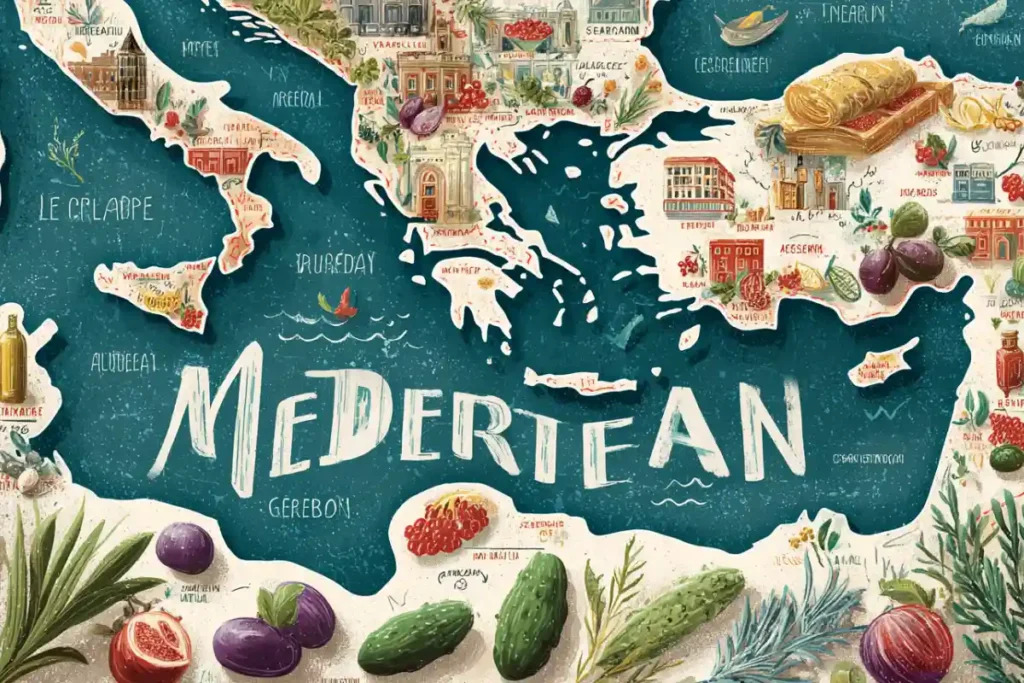
Is Mediterranean Food Arabic?
This is one of the most frequently asked questions and the answer is both yes and no. The term “Mediterranean” refers to the entire region surrounding the Mediterranean Sea, which includes Southern Europe (Greece, Italy, Spain), North Africa (Morocco, Tunisia, Egypt), and the Middle East (Lebanon, Syria, Turkey, and parts of the Arabian Peninsula).
So yes, Arabic cuisine is a part of Mediterranean food, but it’s not the whole picture. Dishes like tabbouleh, fattoush, hummus, and za’atar-spiced salads are examples of Levantine Arabic influences on Mediterranean dining. Meanwhile, Greek salads, Italian antipasti, and French Niçoise dishes also fall under the same umbrella.
The beauty of the Mediterranean cucumber salad is how it borrows from all these cultures bringing together fresh vegetables, herbs, olive oil, and simple seasonings in ways that are uniquely local yet universally delicious.
Origins of the Cucumber Salad Tradition
Cucumber-based salads have existed for centuries across many Mediterranean civilizations. Ancient Greeks valued cucumbers for their cooling, hydrating properties. In Middle Eastern cultures, they were often mixed with yogurt or fresh herbs for refreshing side dishes during hot summer months.
The modern Mediterranean cucumber salad most likely evolved as a hybrid between:
- Greek salad (horiatiki), with cucumbers, olives, and feta
- Arabic salads like Israeli chopped salad or Lebanese salata, which feature finely diced cucumber, tomatoes, parsley, and lemon juice
- Turkish salads such as çoban salatası, known for its rustic mix of tomatoes, cucumbers, and herbs
What they all share is a focus on seasonal, raw vegetables, minimal processing, and herbaceous flavor a concept that’s deeply rooted in both tradition and health.
Influence Across Greece, Turkey, and Lebanon
Each region adds its own spin to the base. Here’s how:
- Greece: Adds briny feta, red onions, and sometimes capers. The flavors are salty, tangy, and bold.
- Turkey: Keeps things rustic with chopped vegetables and lemon-heavy dressings. Mint is often used liberally.
- Lebanon: Introduces parsley and lemon juice, leaning more toward herb-forward brightness. Chickpeas may appear as a hearty add-in.
These regional variations reflect the broader philosophy of the Mediterranean diet: cook with what’s fresh, in season, and grown nearby. It’s not just a salad it’s a way of living and eating that emphasizes balance, community, and care.
FAQs on Mediterranean Cucumber Salad
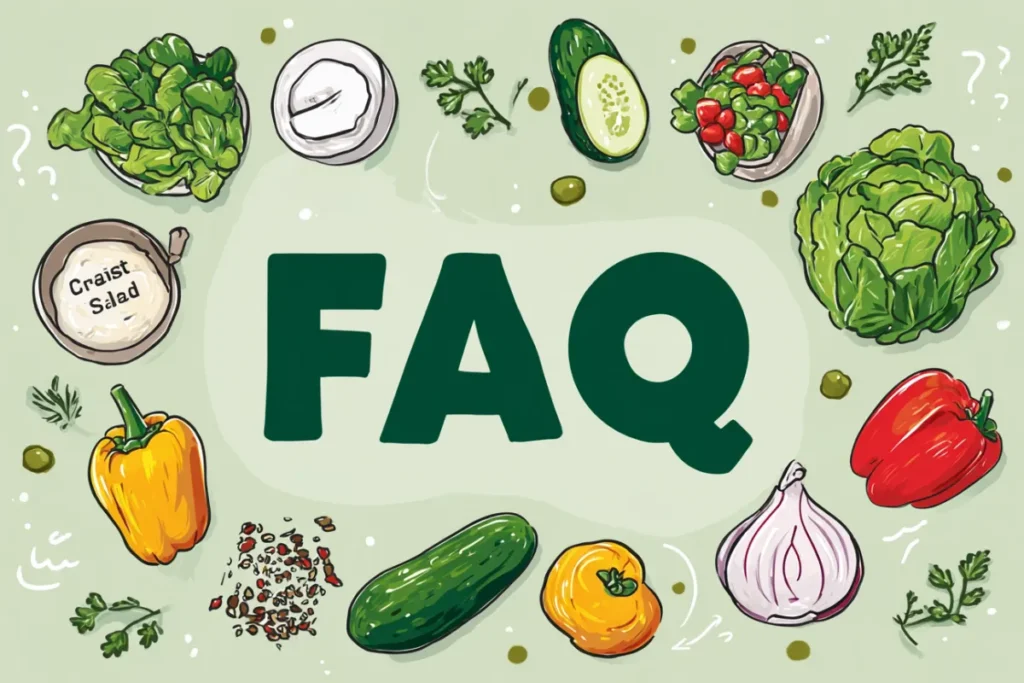
What is a Mediterranean cucumber salad?
Mediterranean cucumber salad is a light, fresh, and flavorful side dish made with chopped cucumbers, tomatoes, red onions, olives, and herbs—typically dressed in a lemony vinaigrette with olive oil. It’s a staple across Mediterranean cuisines and celebrated for its simplicity, vibrant color, and crisp texture. Often served chilled, this salad pairs beautifully with grilled meats, seafood, or plant-based mains.
What does a Mediterranean salad include?
A traditional Mediterranean salad includes fresh vegetables like cucumber, tomato, bell pepper, and red onion, along with briny ingredients like olives or capers. It’s dressed in extra virgin olive oil, often with lemon juice or vinegar, and seasoned with herbs such as parsley, oregano, or mint. Feta cheese and chickpeas are common add-ins depending on regional variations. The focus is always on whole, seasonal, and nutrient-dense ingredients.
What should not be mixed with cucumber salad?
There are a few things you’ll want to avoid to keep your cucumber salad fresh and balanced:
Creamy dressings like mayo or ranch, which can mask the clean, zesty flavors.
Excess water from overly juicy vegetables (like peeled zucchinis) that can make the salad soggy.
Overpowering spices or too much salt, which can draw out moisture from the cucumbers and make the salad weepy.
Mixing the dressing too early—especially if storing the salad—can lead to a mushy texture.
For best results, dress your salad just before serving and avoid ingredients that overpower the fresh profile.
What is the difference between a Greek and Mediterranean salad?
While all Greek salads are Mediterranean, not all Mediterranean salads are Greek. The main difference lies in the ingredients:
A Greek salad often includes large tomato wedges, cucumber slices, feta cheese, red onions, Kalamata olives, and a red wine vinaigrette. It’s chunkier and saltier.
A Mediterranean cucumber salad can vary by country and may include mint, parsley, chickpeas, or lemon-based dressings. It’s often more finely chopped and sometimes cheese-free.
Think of Greek salad as a regional variant with its own bold, iconic style.
Is Mediterranean food Arabic?
Mediterranean food includes a wide range of cuisines from countries surrounding the Mediterranean Sea—including Greece, Italy, Spain, Turkey, Lebanon, and Egypt. Arabic cuisine, especially from the Levant (Lebanon, Syria, Jordan, Palestine), is a major part of Mediterranean food. Staples like hummus, tabbouleh, fattoush, and cucumber salads are all Arabic contributions to the broader Mediterranean diet.
So yes, Arabic food is Mediterranean, but Mediterranean food also includes European and North African influences.
What is in cucumber salad?
A basic cucumber salad contains chopped cucumbers, tomatoes, red onion, and often herbs like dill or parsley. In a Mediterranean version, you’ll also find olives, olive oil, lemon juice or vinegar, and optional ingredients like feta cheese or chickpeas. The dressing is usually a simple mix of oil, acid, salt, pepper, and sometimes garlic or oregano.
Final Thoughts on Mediterranean Cucumber Salad
There’s something incredibly satisfying about a dish that checks all the boxes refreshing, flavorful, easy to prepare, and deeply nourishing. That’s what the Mediterranean cucumber salad delivers every single time. Whether you’re crafting a quick lunch, hosting a cookout, or simply looking for a way to eat more colorfully, this salad is a smart, delicious choice.
We’ve explored everything from traditional ingredients to dressings, cultural background, and even how to store leftovers the right way. Now it’s your turn to bring it to life in your kitchen.
And remember: recipes like this are more than food. They’re invitations to slow down, connect, and enjoy the beauty of real, vibrant ingredients.
Happy cooking,
Mia from EatBrightly
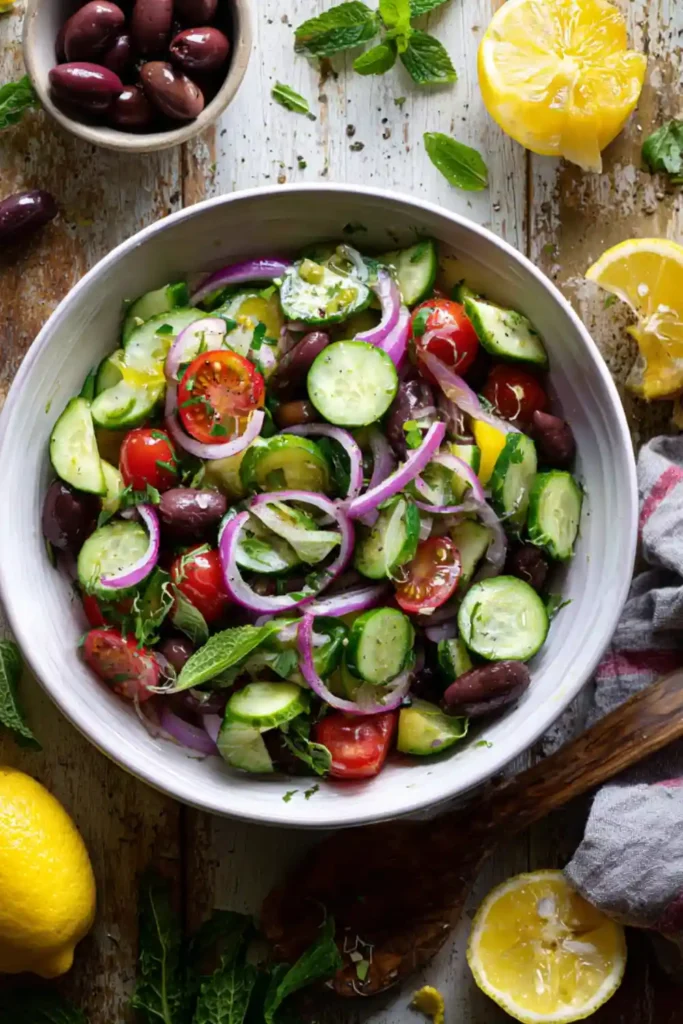
Fresh Mediterranean Cucumber Salad with Lemon-Herb Vinaigrette
A fresh and vibrant Mediterranean cucumber salad made with crisp cucumbers, juicy tomatoes, red onions, olives, herbs, and a zesty lemon-herb vinaigrette. Light, healthy, and perfect as a side or main dish.
- Prep Time: 10 minutes
- Cook Time: 0 minutes
- Total Time: 10 minutes
- Yield: 4 servings
- Category: Salad
- Method: No-Cook
- Cuisine: Mediterranean
- Diet: Vegetarian
Ingredients
- 1 cup fresh watermelon, cubed or balled (seedless preferred)
- 1–2 sprigs fresh rosemary, lightly bruised
- 4 cups filtered water
- Lime slice (optional, for tang)
- Ice cubes (optional, especially in hot weather)
Instructions
In a large bowl, combine cucumber, tomatoes, red onion, olives, parsley, and mint.
In a small jar or bowl, whisk together olive oil, lemon juice, minced garlic, oregano, salt, and pepper.
Pour the dressing over the salad ingredients and toss gently to combine.
Sprinkle feta cheese on top, if using.
Serve immediately or refrigerate for up to 1 hour before serving.
Notes
For extra crunch, add chopped bell peppers or radishes.
To keep it dairy-free, skip the feta or use a vegan cheese substitute.
If making ahead, store the salad and dressing separately until ready to serve.
Try adding chickpeas or grilled chicken for a protein-packed main dish.
Nutrition
- Serving Size: 1 cup (approx. 200g)
- Calories: 210
- Sugar: 3g
- Sodium: 320mg
- Fat: 18g
- Saturated Fat: 4g
- Unsaturated Fat: 13g
- Trans Fat: 0g
- Carbohydrates: 9g
- Fiber: 3g
- Protein: 4g
- Cholesterol: 10mg
Keywords: Mediterranean cucumber salad, cucumber salad recipe, healthy summer salad, lemon herb cucumber salad, low carb salad, vegetarian Mediterranean salad, gluten-free salad recipe, no cook cucumber salad, easy Mediterranean recipe, fresh herb salad, tomato cucumber olive salad, feta cucumber salad, simple summer salad


